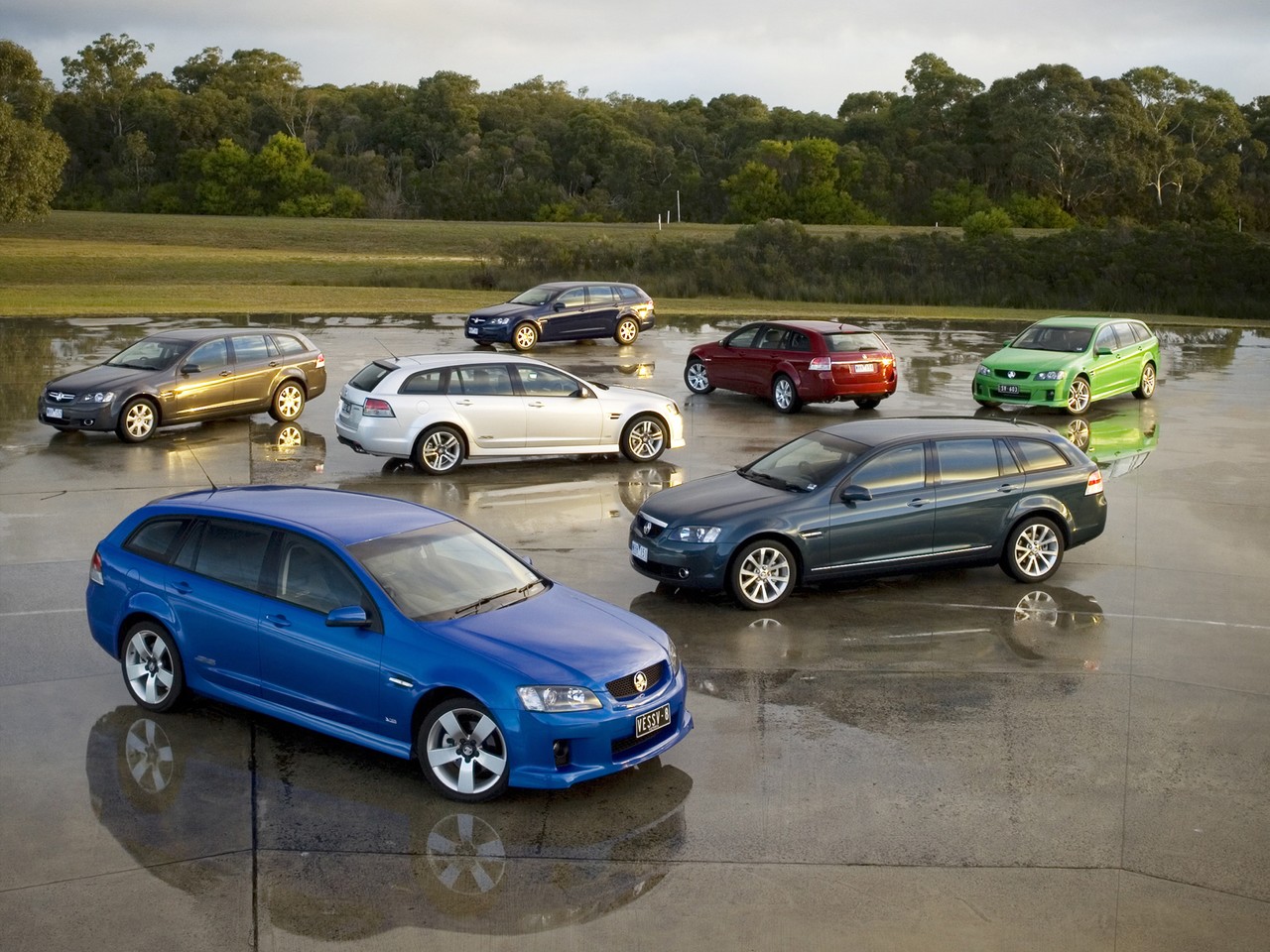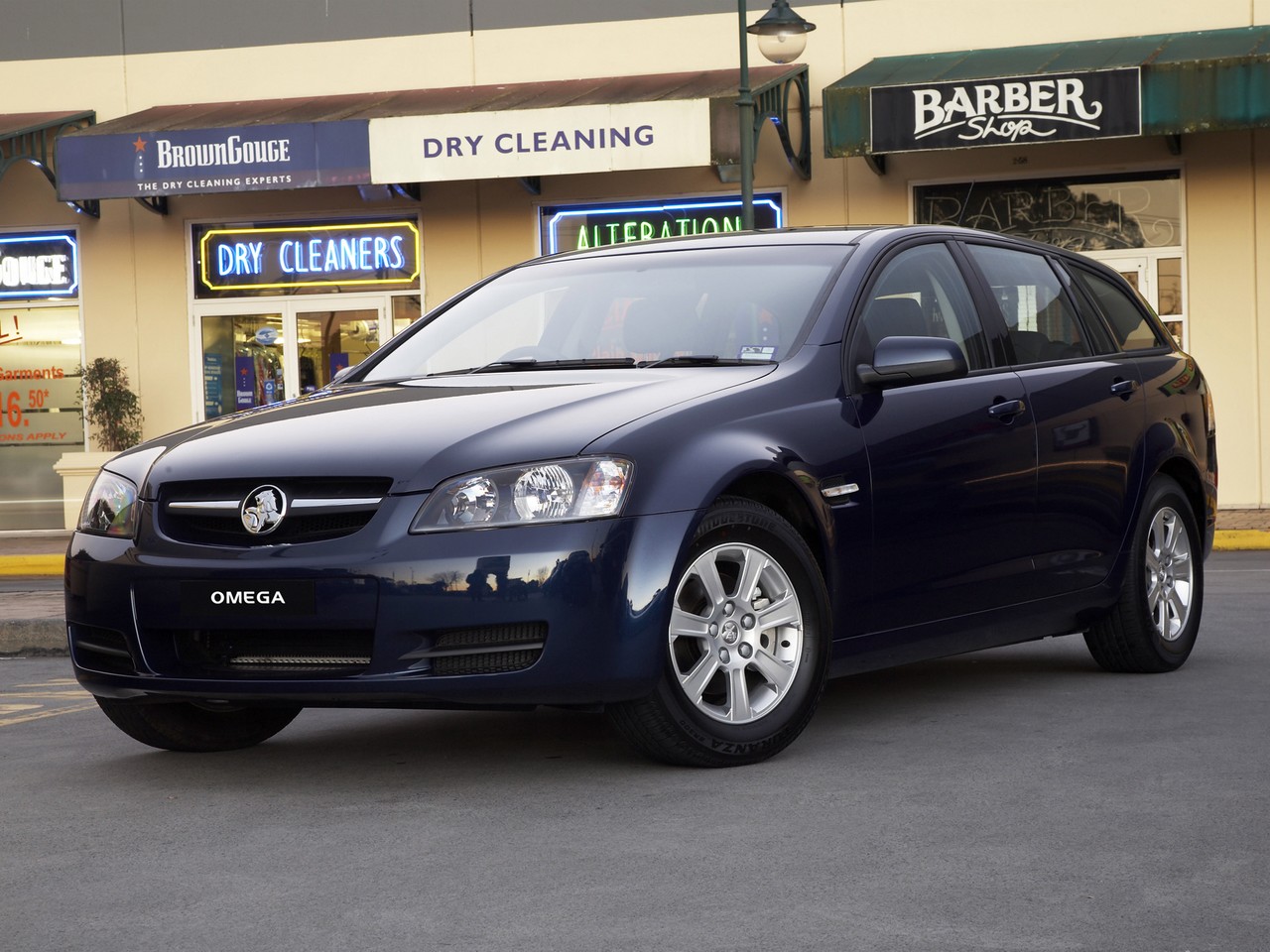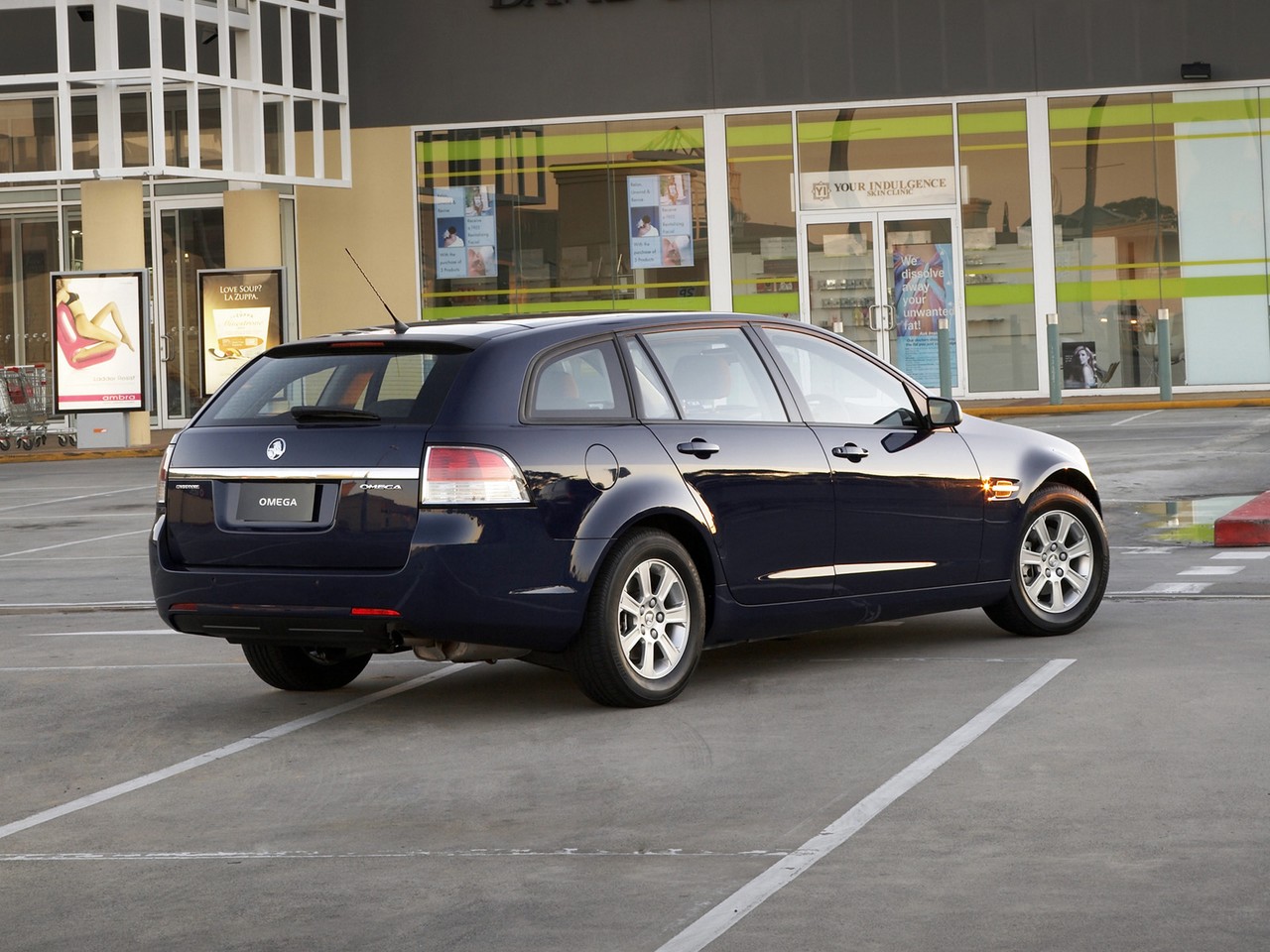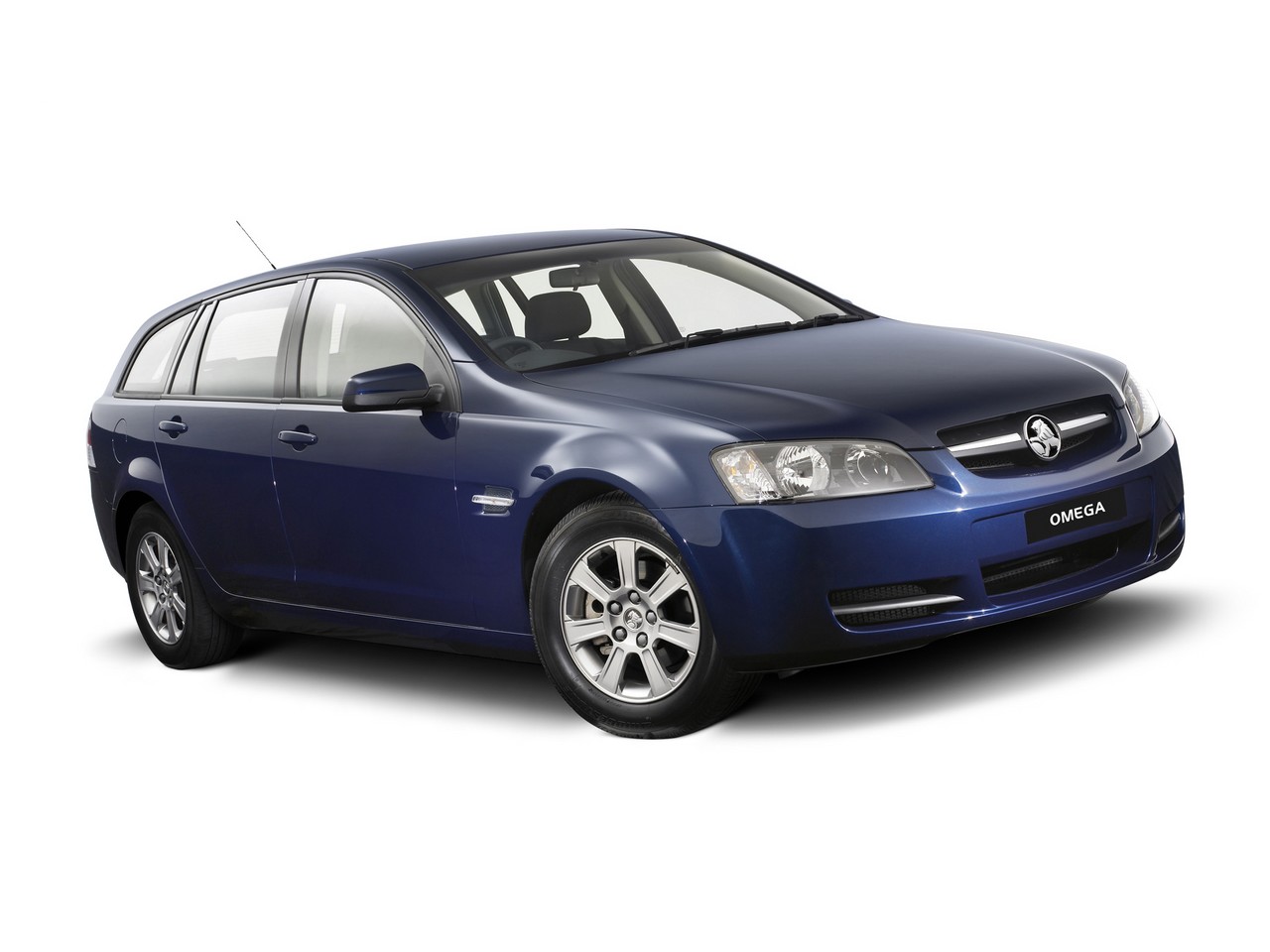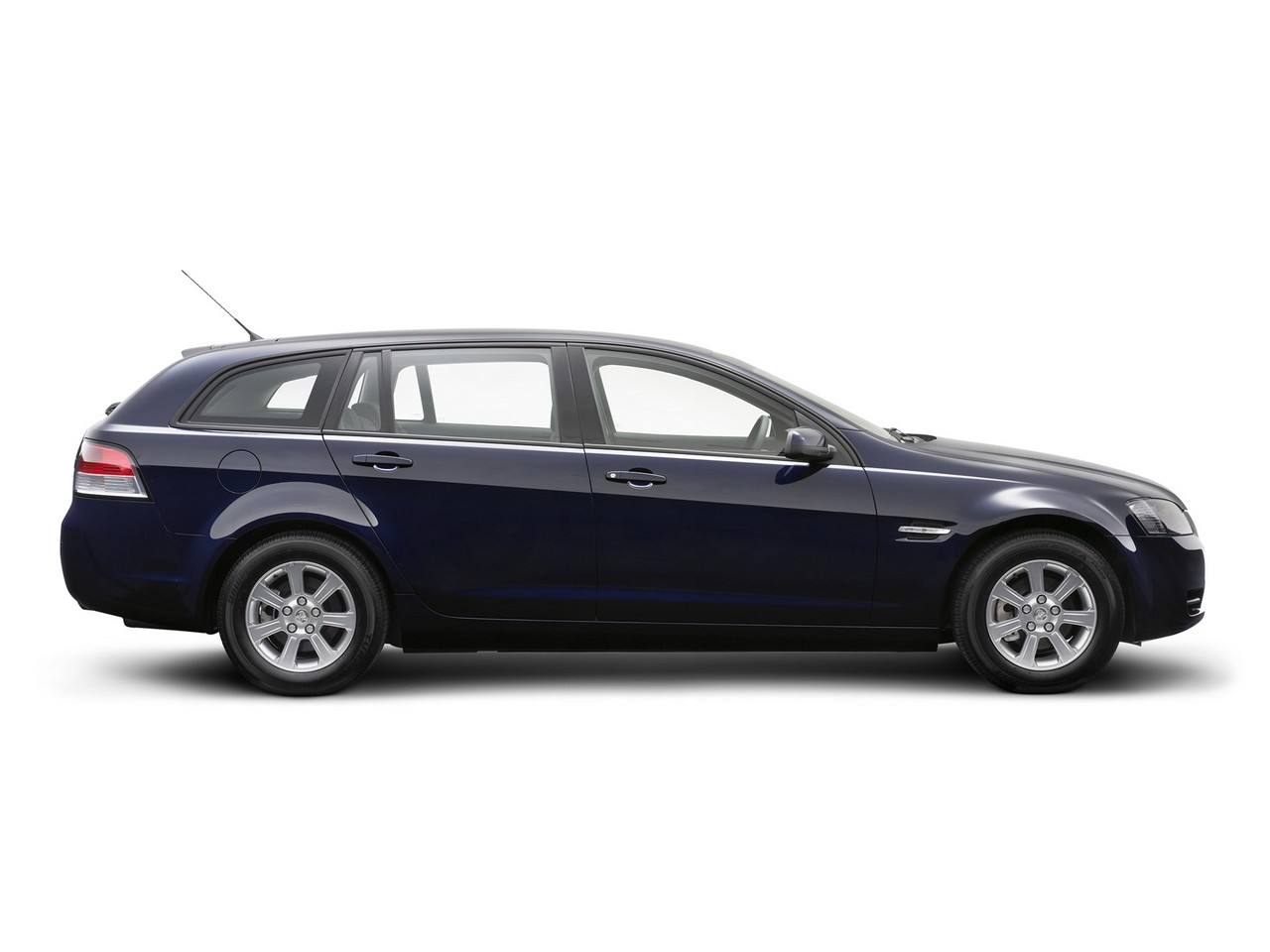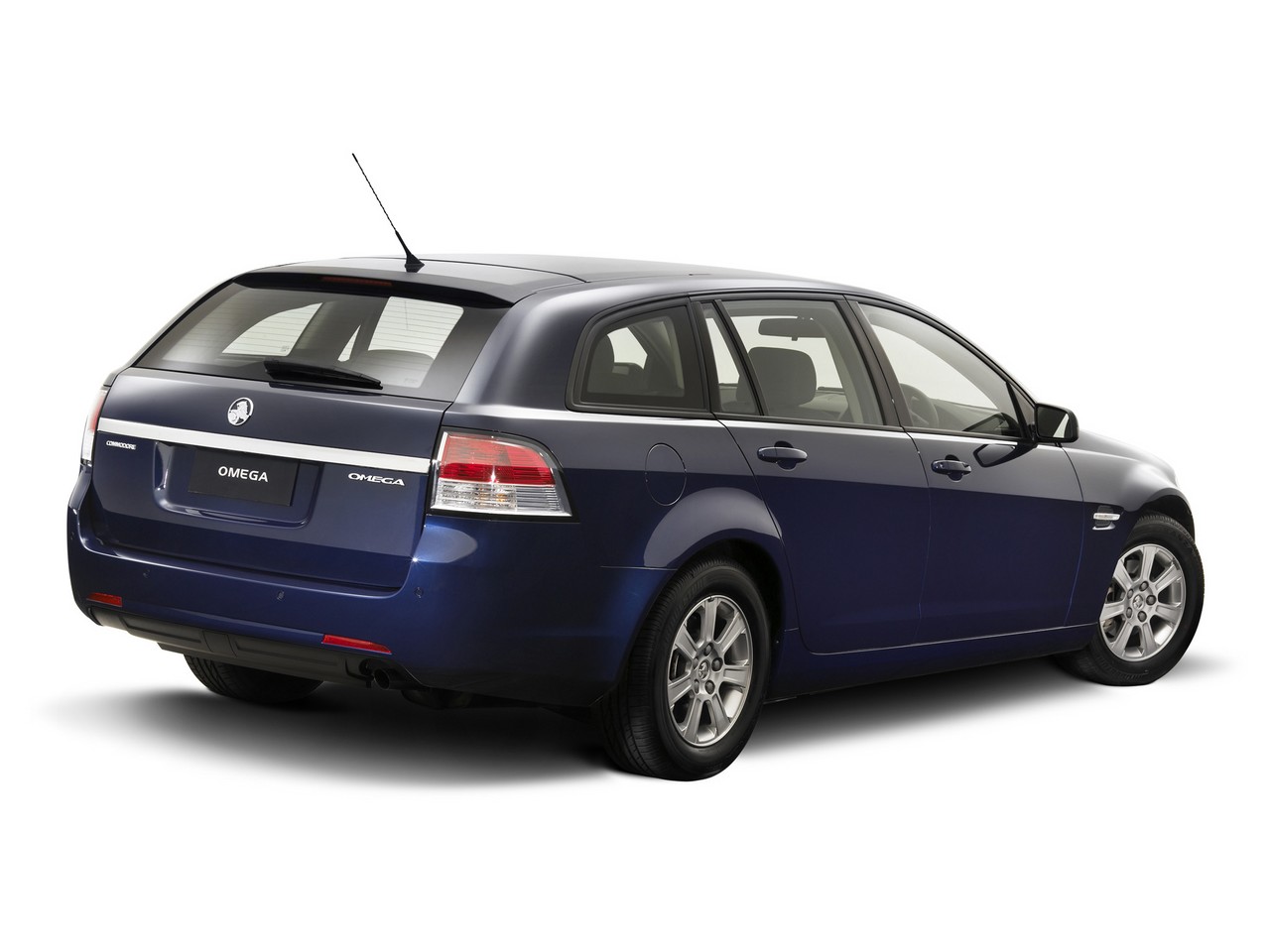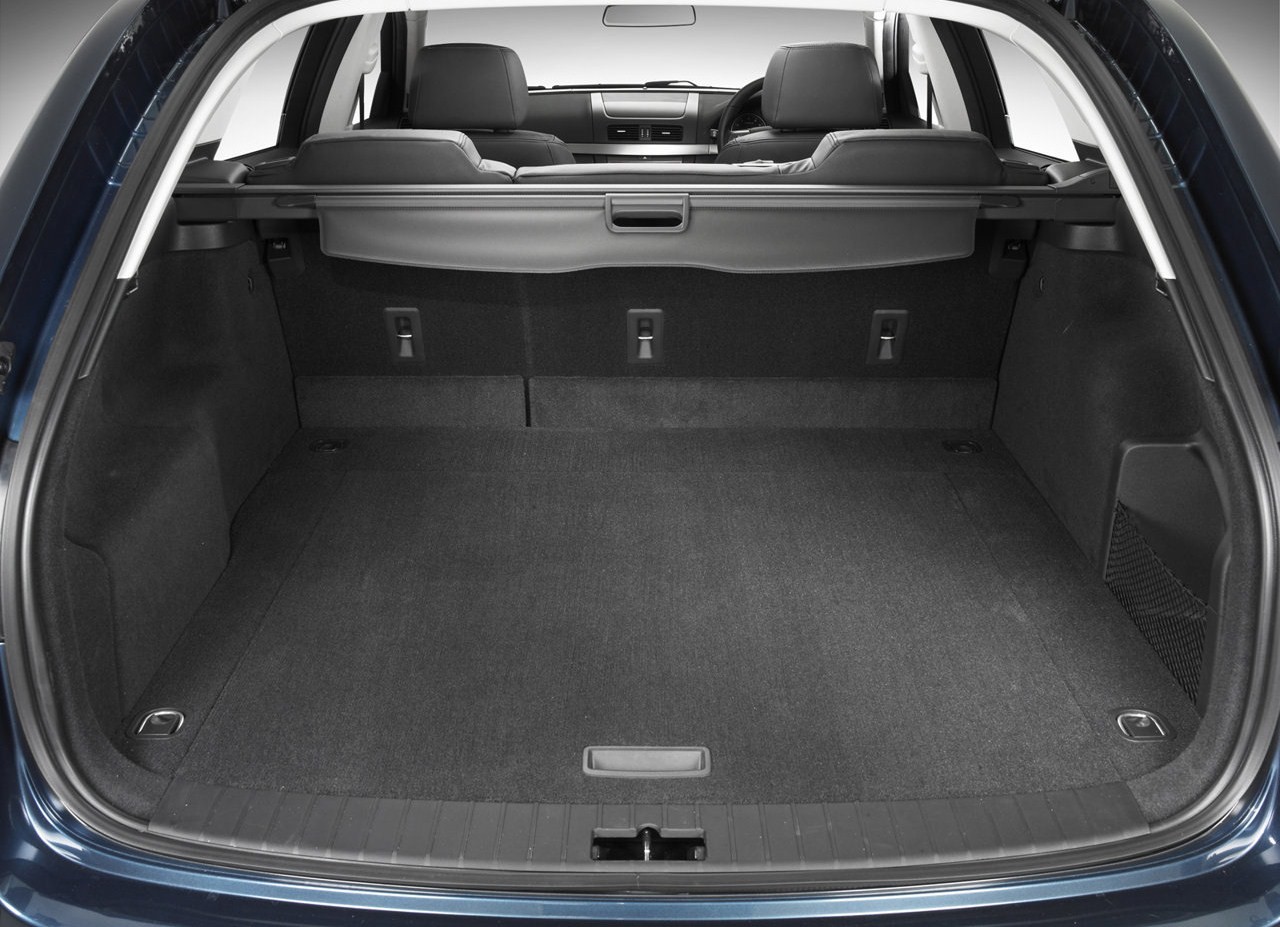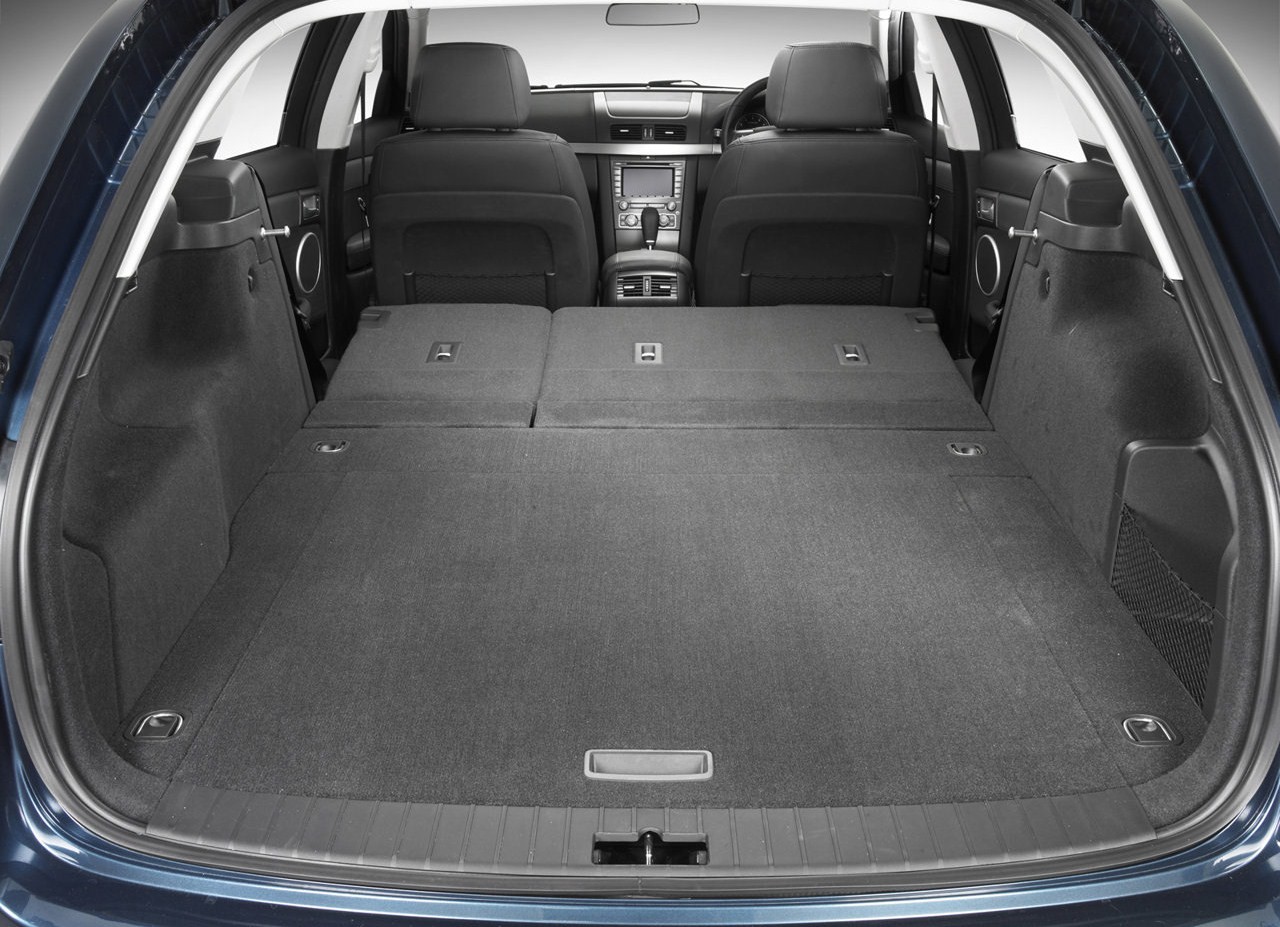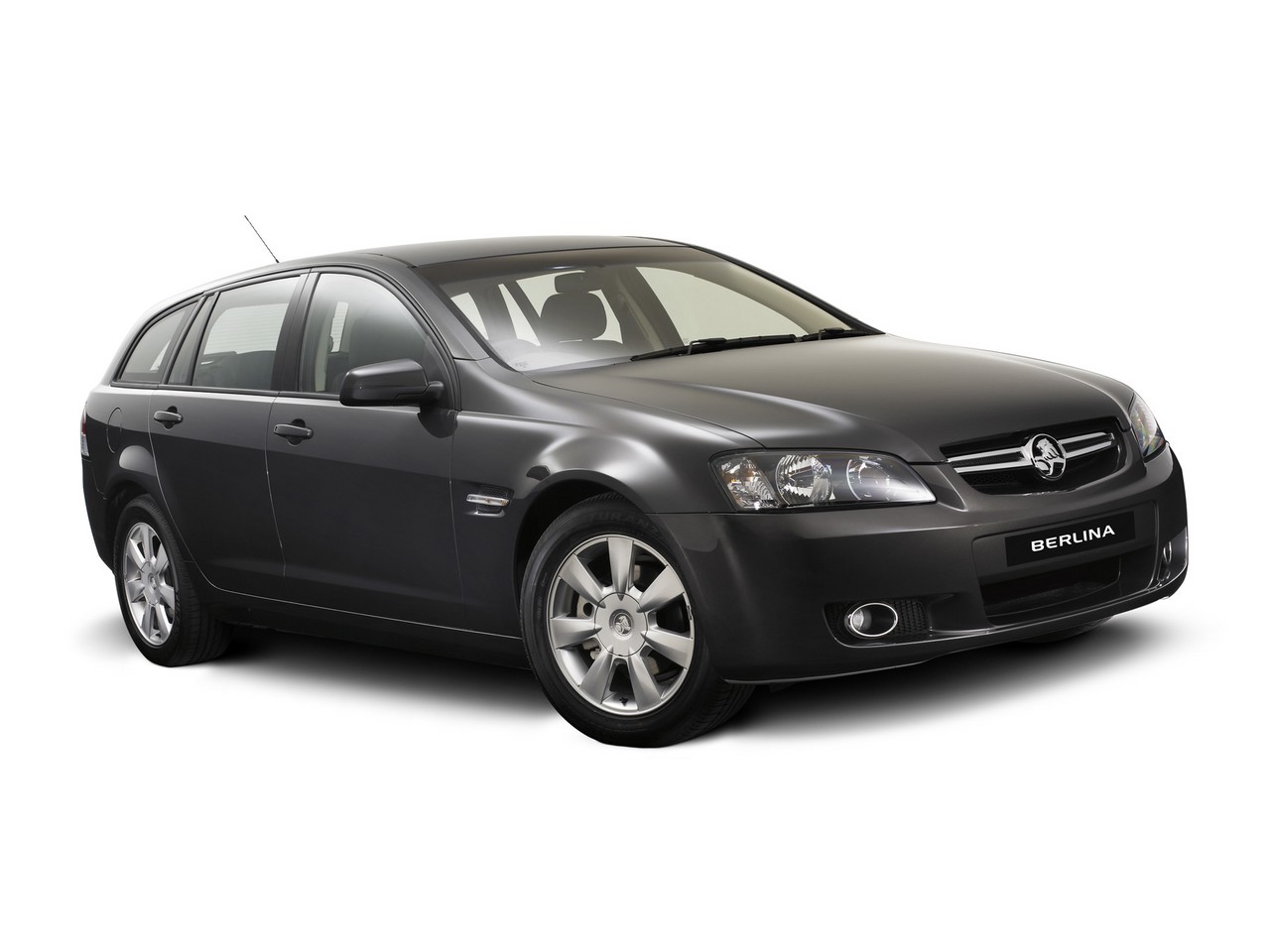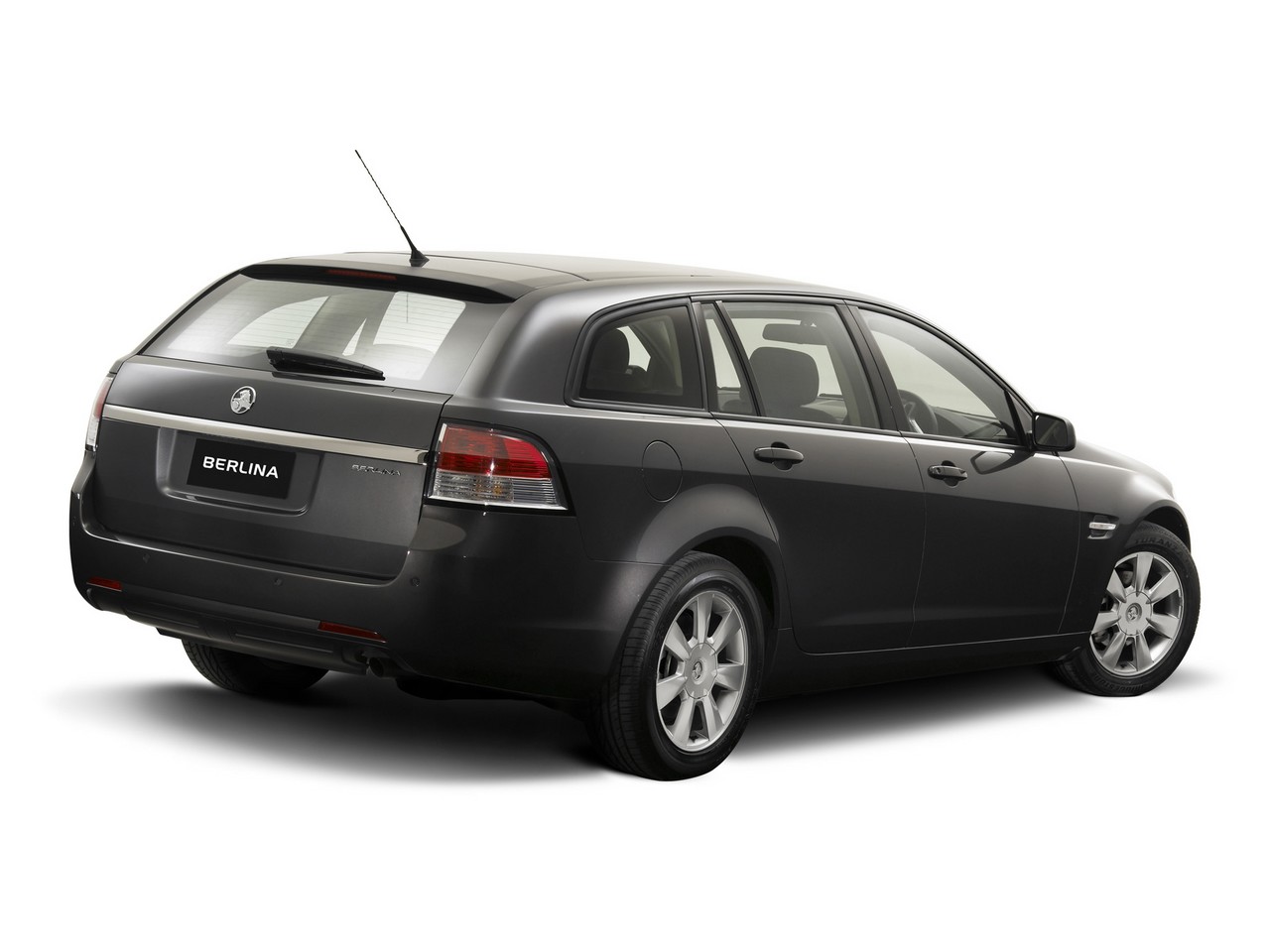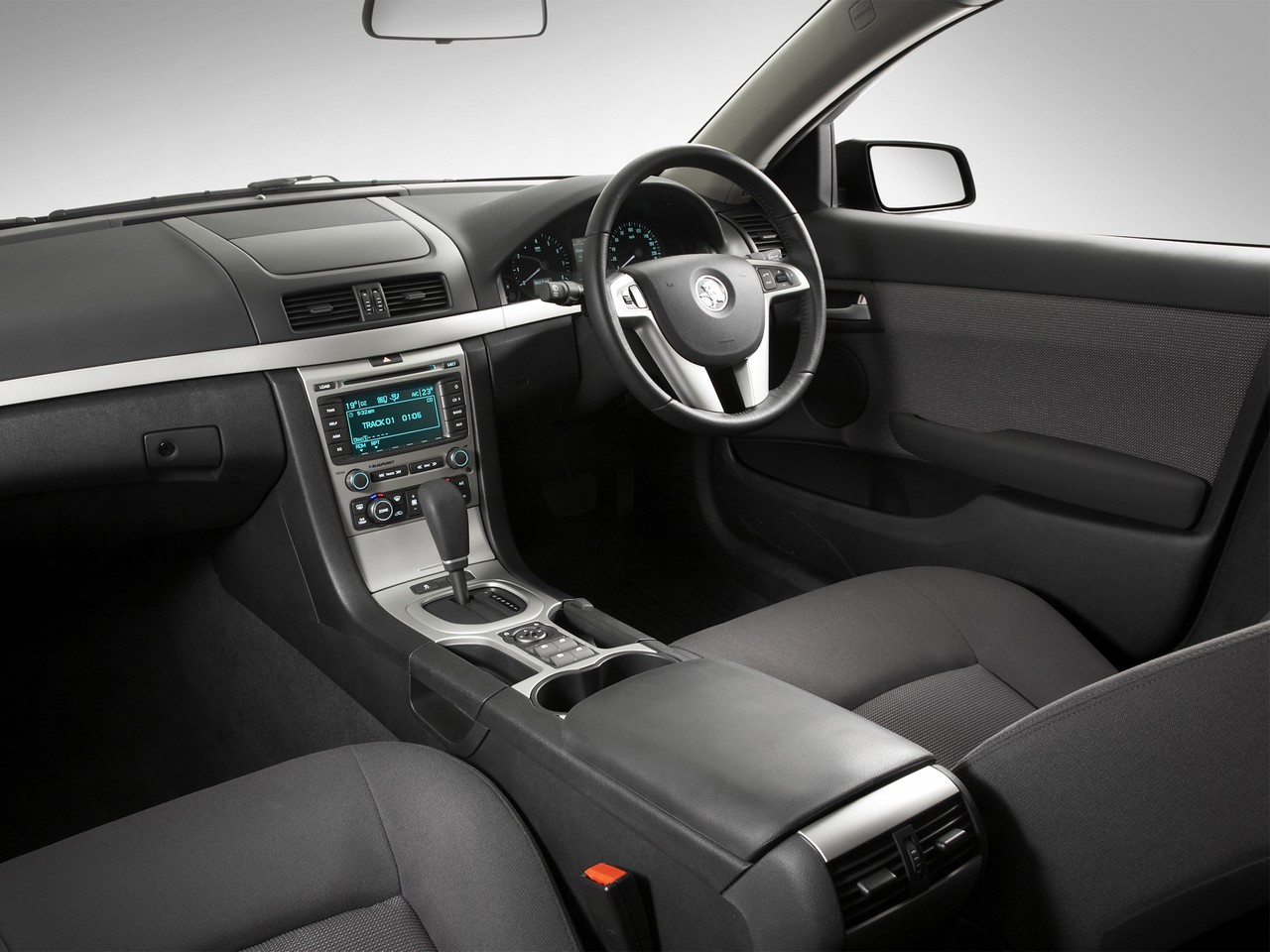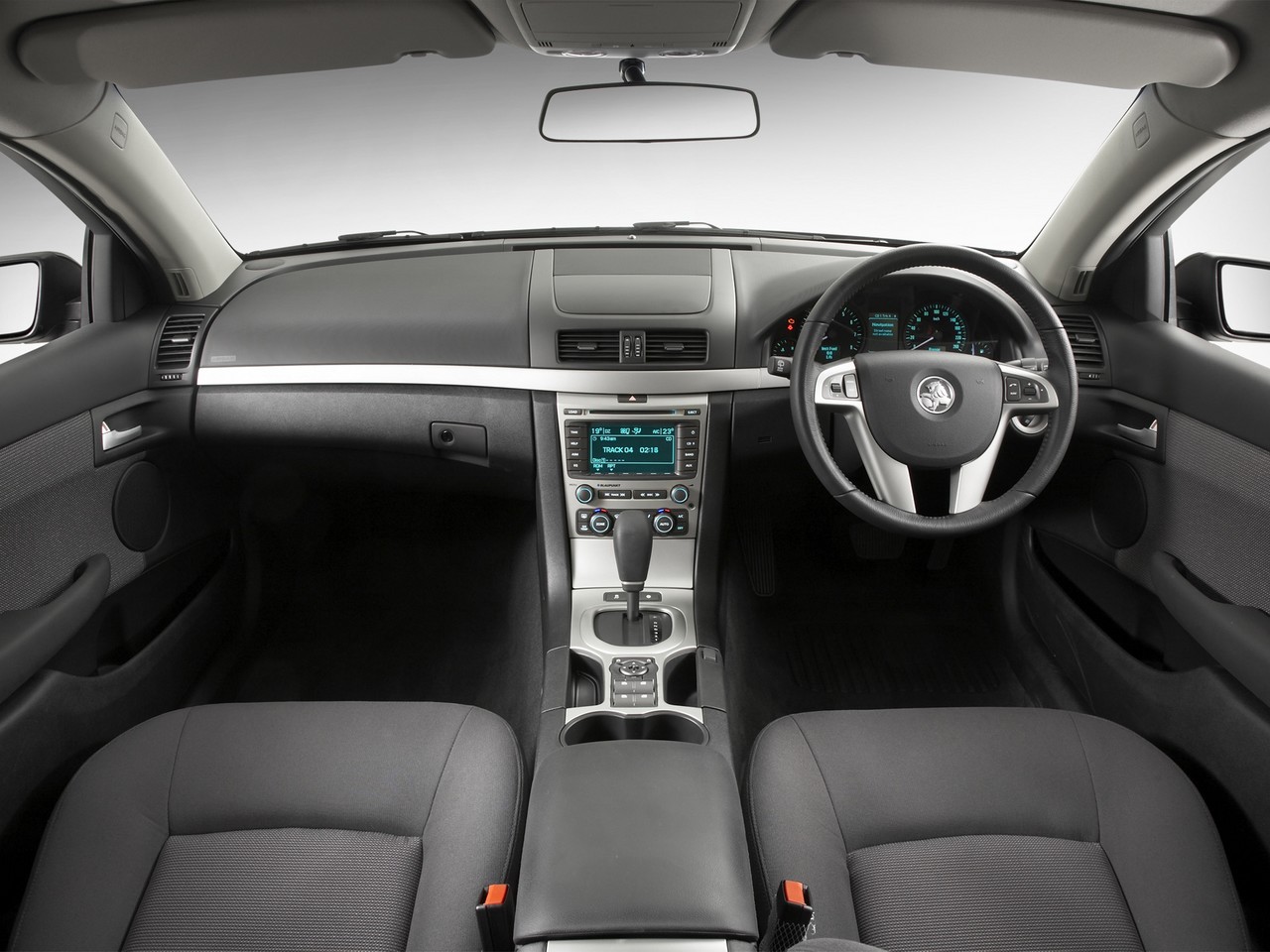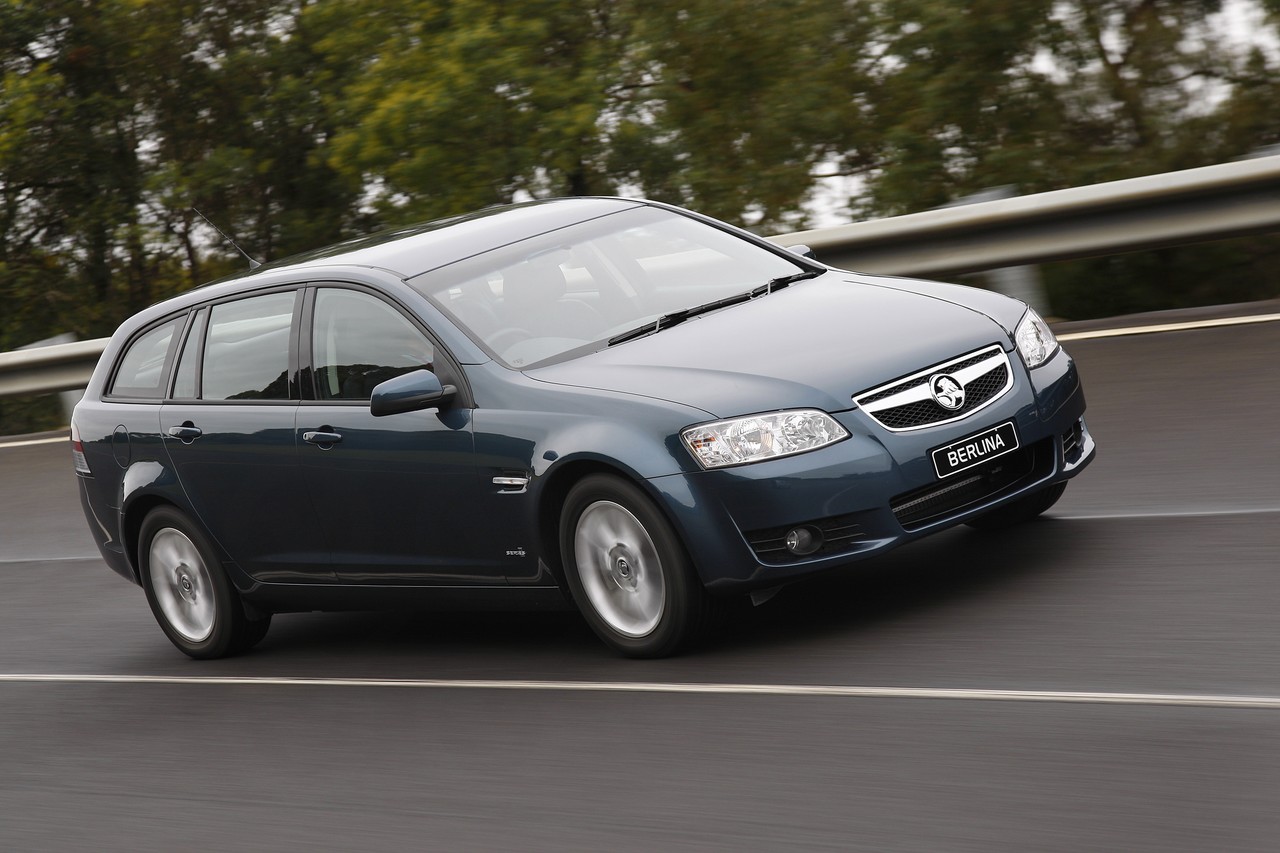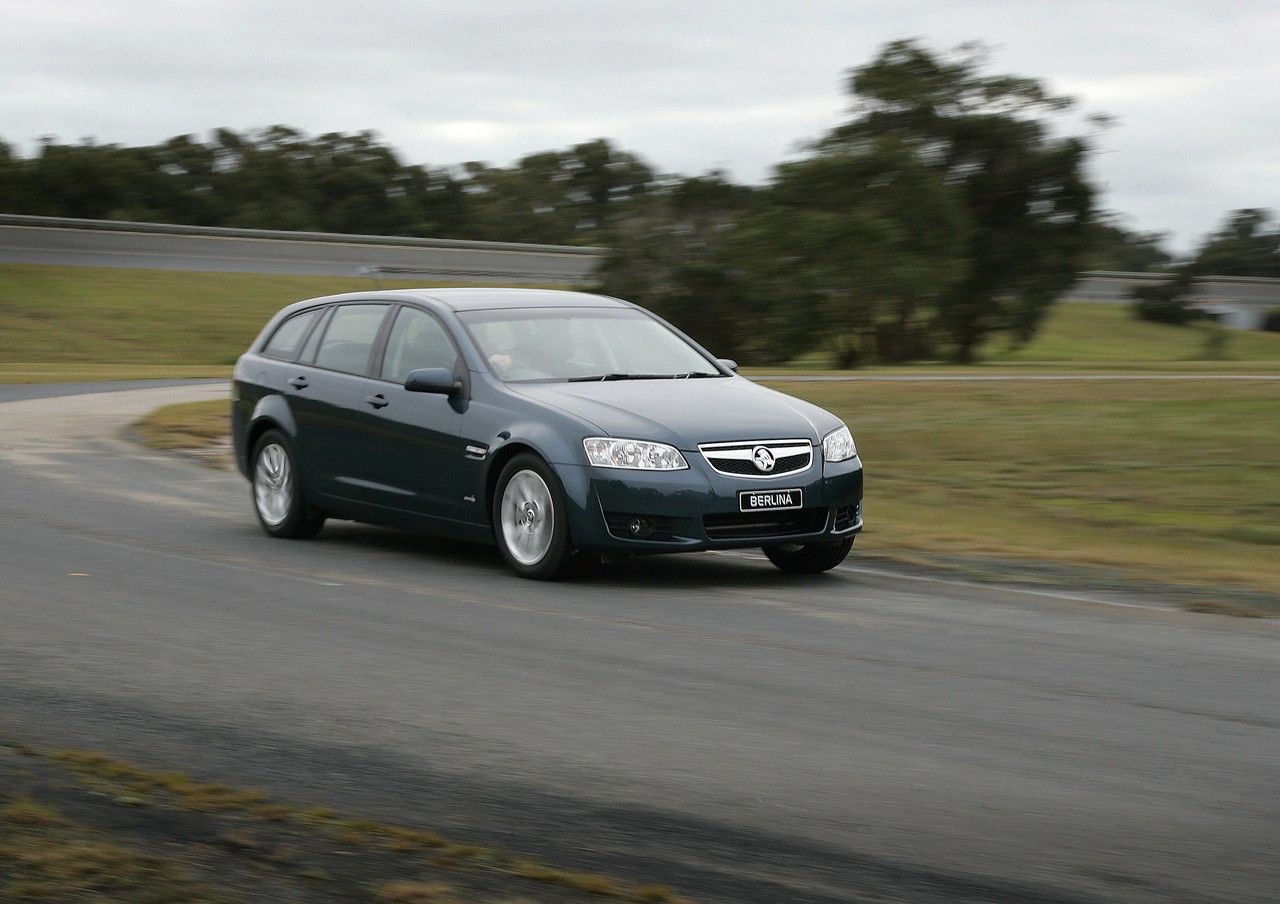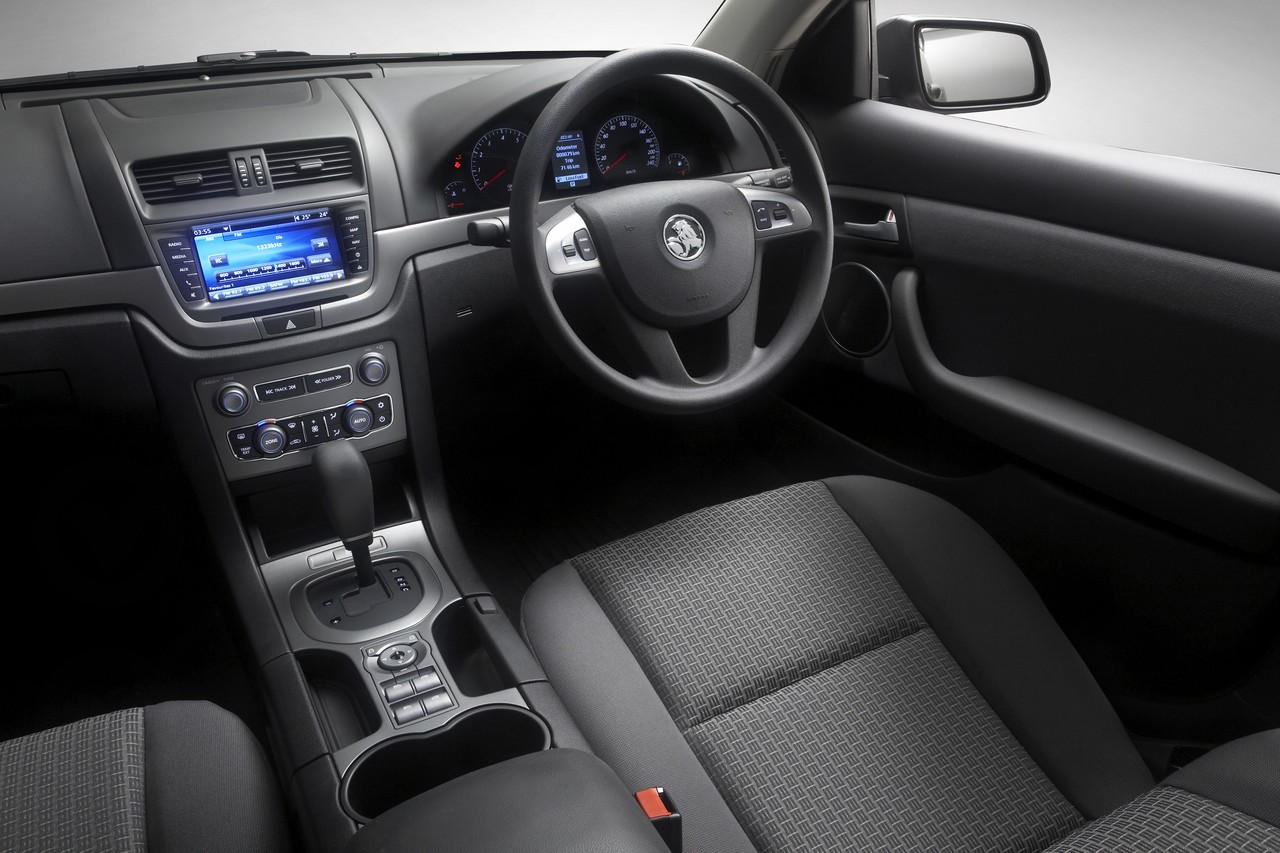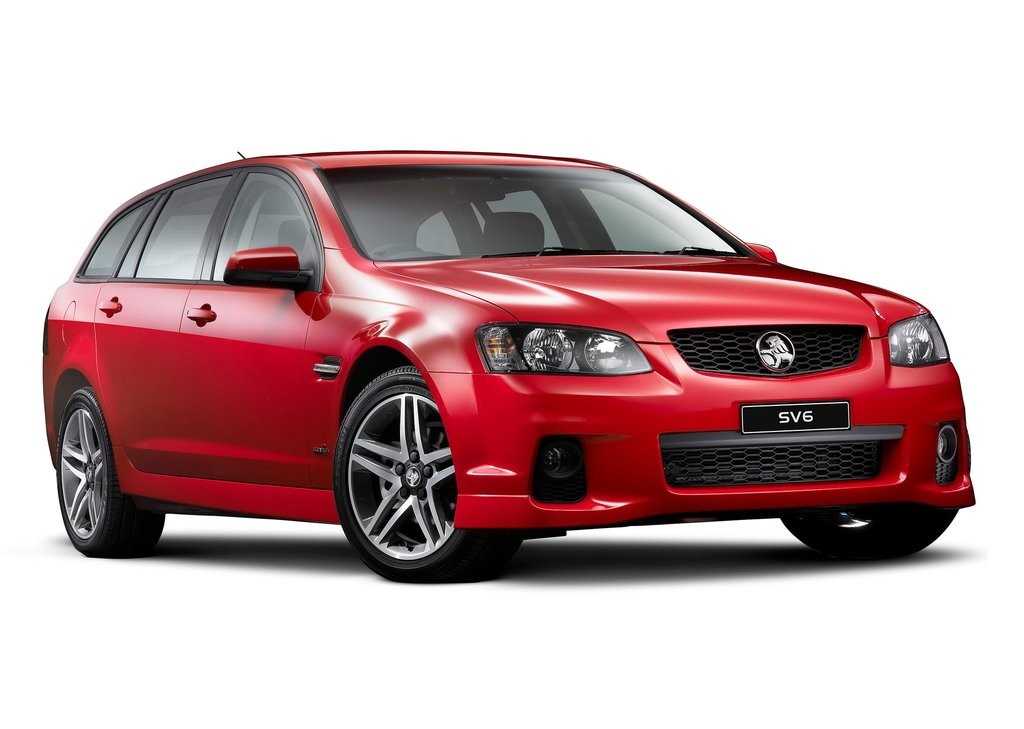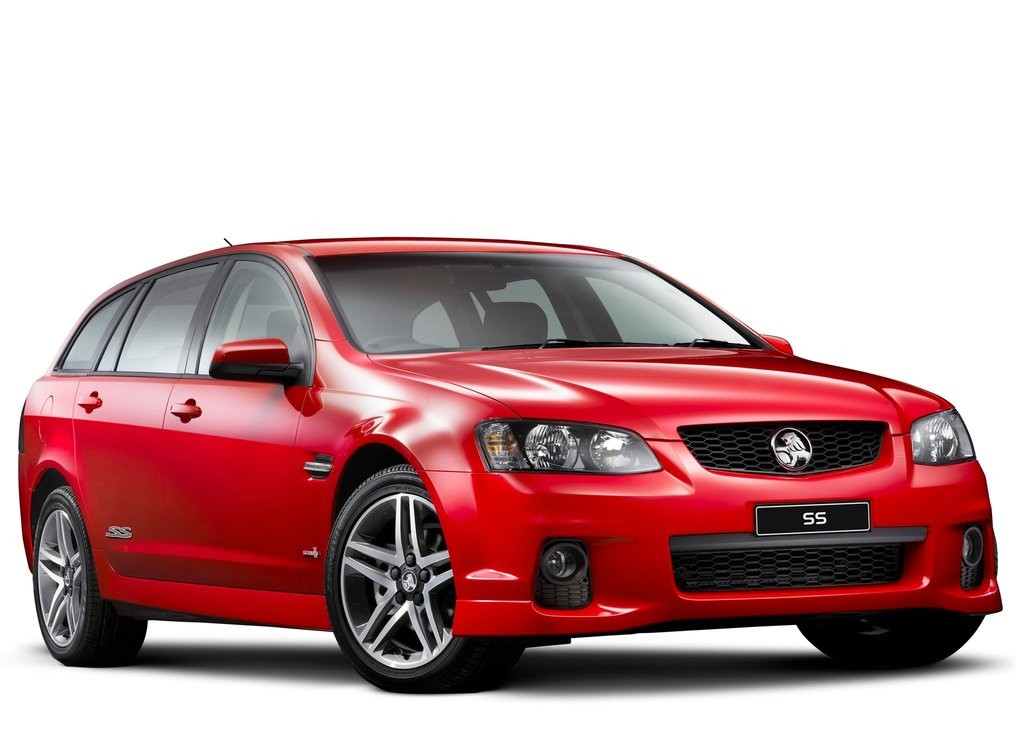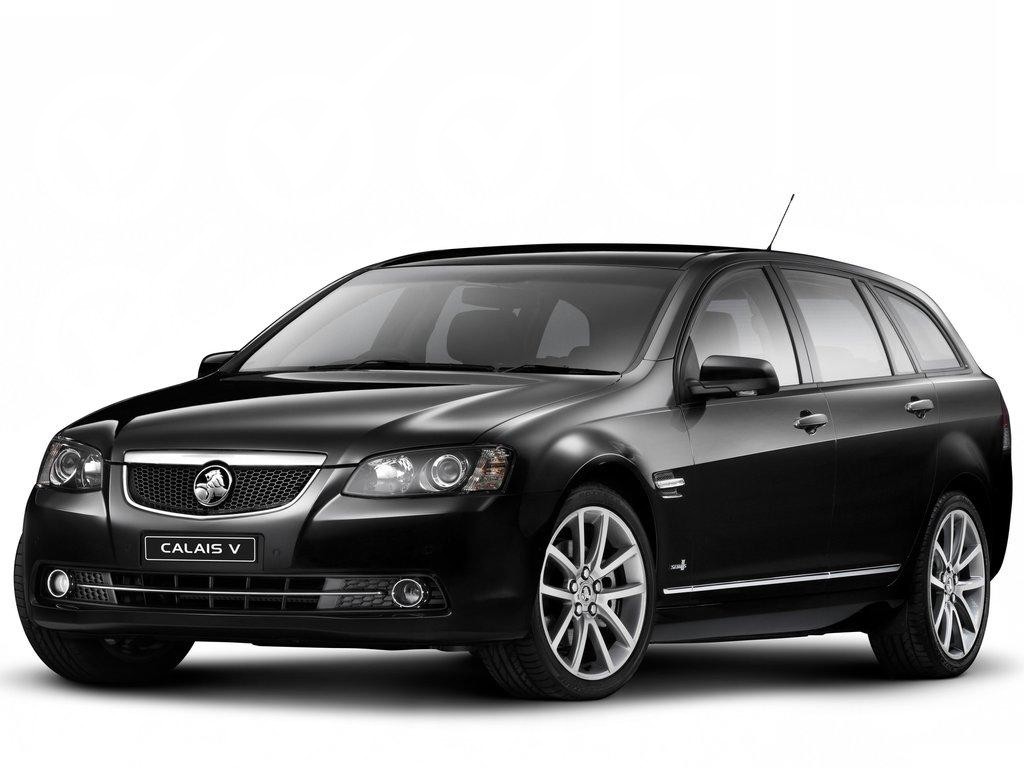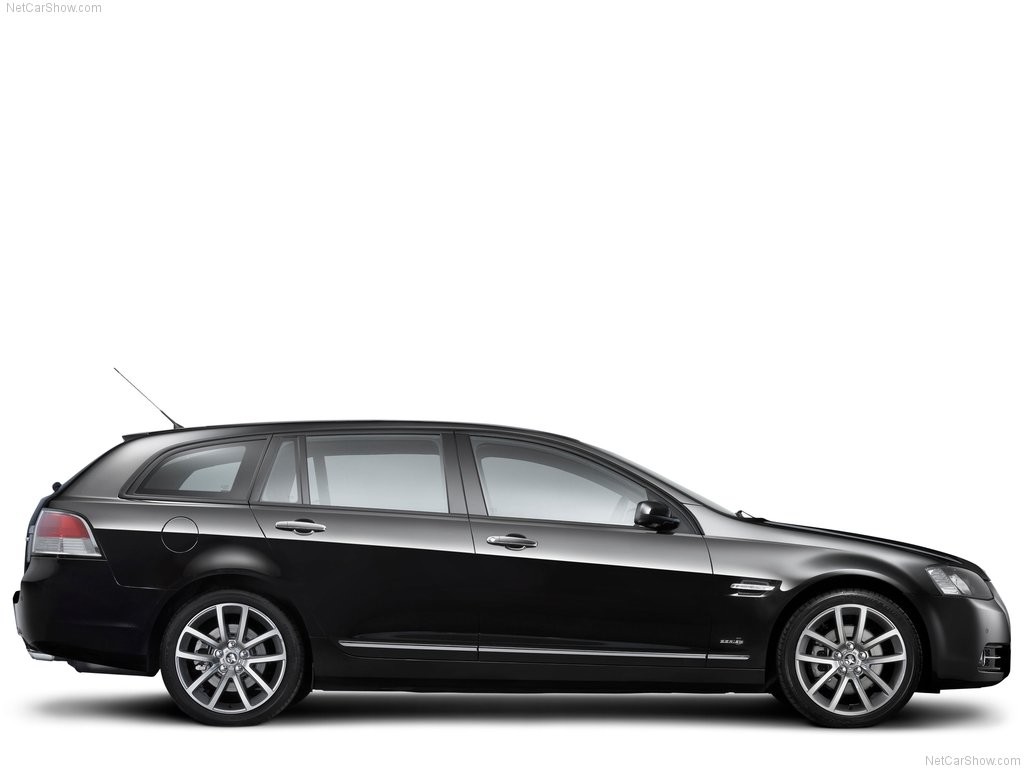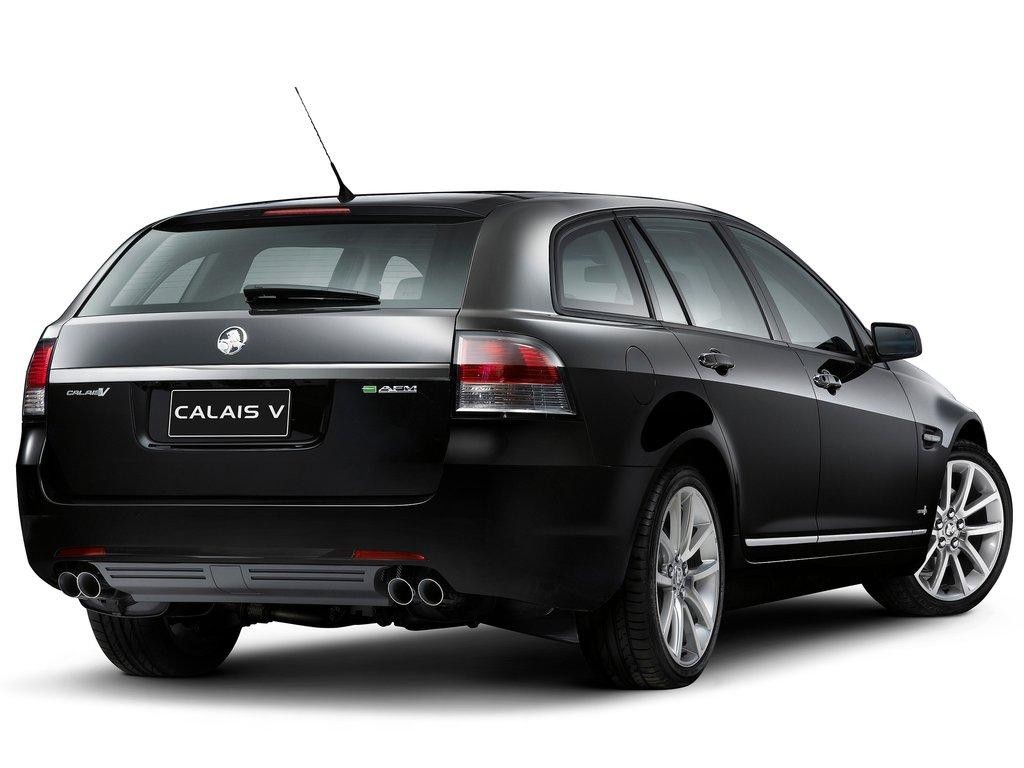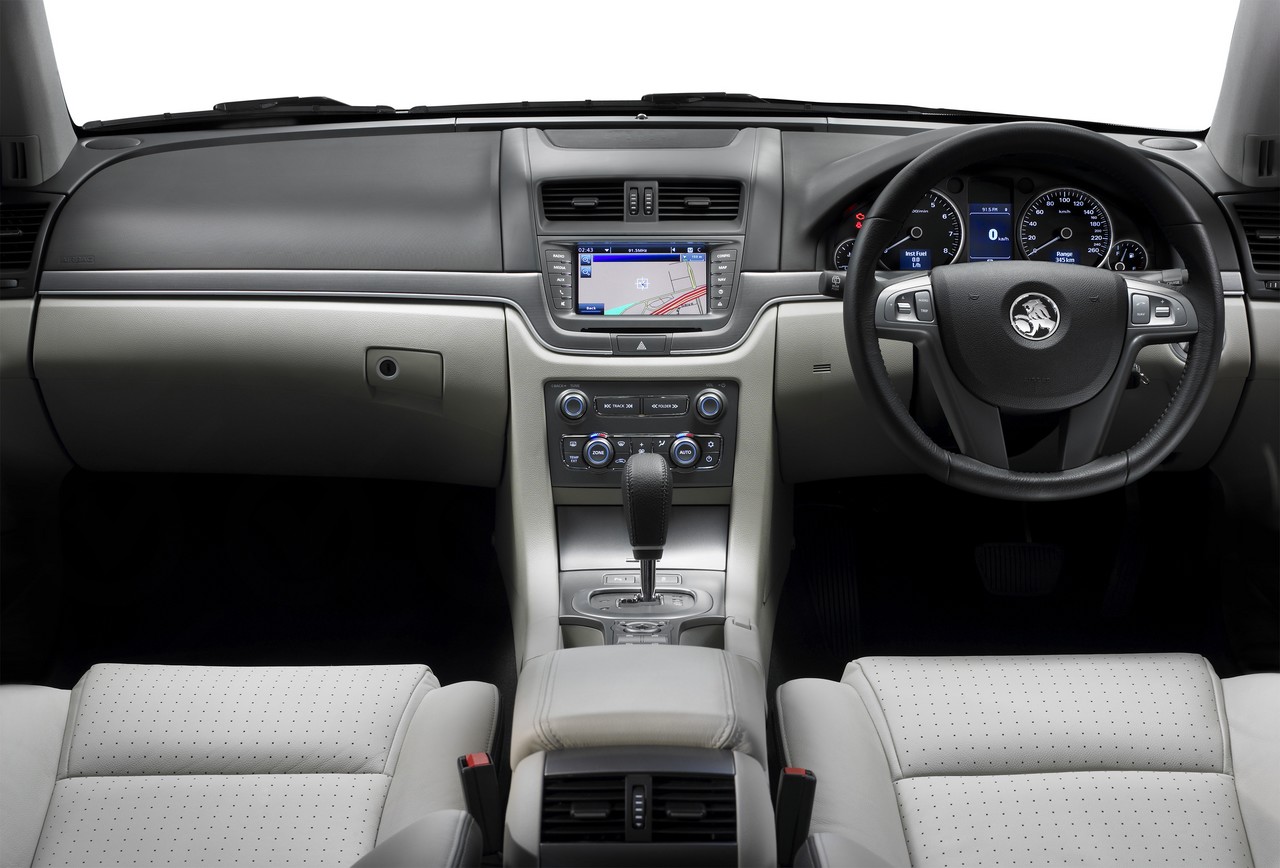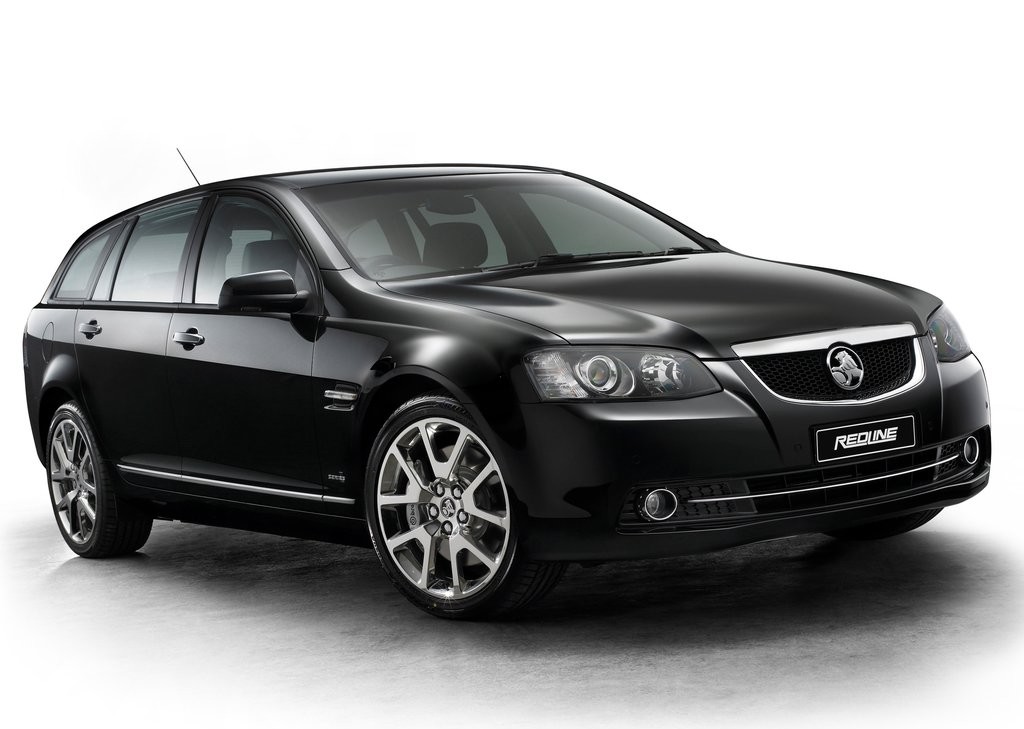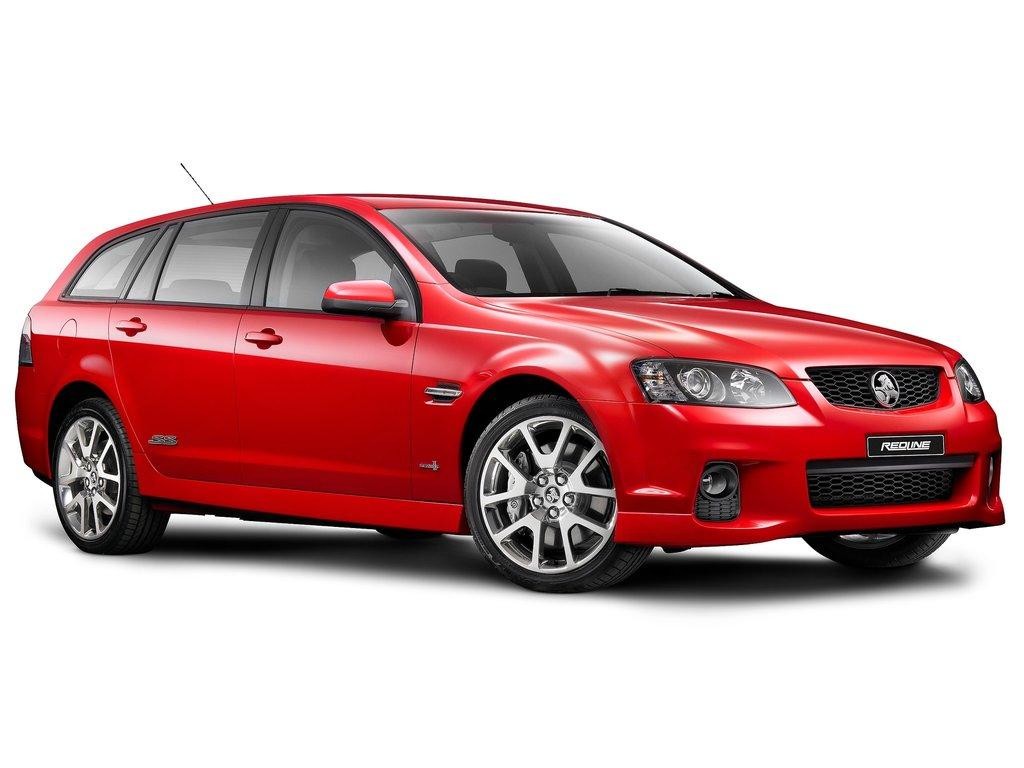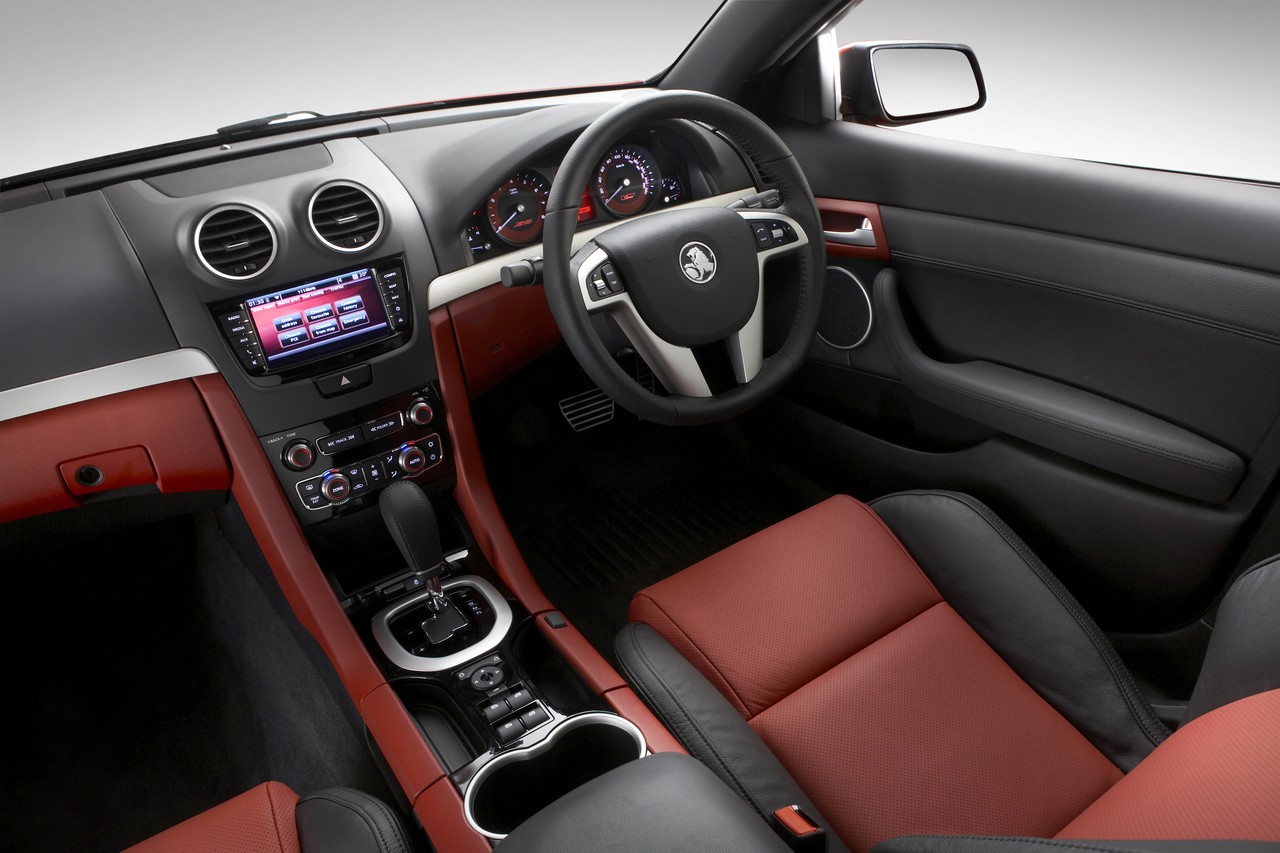
- 3.6-litre ‘Alloytec’ V6 engines lack refinement
- Thick A-pillars impair forward visibility
- Awkward handbrake position and operation
- Clunky downshifts for four-speed automatic transmission
- Heavy body hurts fuel economy
- Carbon deposits on intake valves of direct injection V6 engines
Holden VE.I Sportwagon (2008-10)
Overview
Released in July 2008, the Holden VE Series I (VE.I) Sportwagon was a large wagon. Manufactured in Elizabeth, South Australia, the rear-wheel drive VE Sportwagon was initially available with 3.6-litre V6 and 6.0-litre V8 petrol engines. Released as a distinct model from the VE Commodore sedan, the Sportwagon range consisted of Omega, Berlina, Calais, Calais V, SV6, SS and SS V variants.
Engines: V6 Alloytec, LPG V6, L98 V8 and L76 V8
Of the engines,
- For the Sportwagon Omega and Berlina, the 3.6-litre ‘Alloytec’ LE0 V6 petrol engine had all-aluminium construction, a forged steel crankshaft, forged powdered metal connecting rods, double overhead camshafts (DOHC), four valves per cylinder, continuously variable intake camshaft phasing, electronic throttle control, twin knock control sensors and a compression ratio of 10.2:1. For the VE range, the Alloytec engines were fitted with new variable intake manifolds, Bosch E77 engine control systems with digital sensors for crank and camshaft positions, front and rear oxygen (O2) sensors, retuned harmonic balancers and free-flowing exhaust systems. In November 2008 (‘MY09.5’), the engine was modified for lower emissions and improved fuel economy;
- For models with the LE0 engine, buyers could specify a factory-fitted dual fuel (petrol/LPG) system that was developed by IMPCO and provided sequential vapour gas injection. Designated LW2 , the dual fuel engine had different valves and hardened titanium valve seats;
- For the Sportwagon SV6, the high-output LY7 version of this engine also had continuously variable exhaust camshaft phasing and a new dual exhaust system;
- From September 2009 (‘MY10’), the port-injected V6 engines were replaced by the 3.0-litre LF1 and 3.6-litre LLT V6 petrol engines which had direct injection (Holden’s Spark Ignition Direct Injection or SIDI) – whereby fuel was pressurised and injected directly into the combustion chamber compression – and variable exhaust camshaft phasing (previously omitted from the LE0 ). The 3.0-litre LF1 (for Omega and Berlina) and 3.6-litre LLT (for Calais and SV6) engines had compression ratios of 11.7:1 and 11.3:1, respectively, and were fitted with dual exhaust systems;
- For the Sportwagon SS and SS V, the 6.0-litre L98 pushrod V8 engine had all-aluminium construction, flat-topped pistons, forged powered metal connecting rods, a billet steel camshaft, two valves per cylinder, external knock sensors and a compression ratio of 10.4:1; and,
- From January 2009, the Sportwagon SS and SS V variants – with automatic transmissions – were powered by 6.0-litre L76 engines which had displacement on demand hardware (Holden’s Active Fuel Management or AFM) that could shut down four cylinders under light throttle loads in higher gears. Although similar to the L98 engine, the L76 engine had a different camshaft profile and a smaller sump.
For the VE range, new engine control systems were introduced which used digital sensors for crank and camshaft positions. Service intervals for the V8 engines were also extended to 15,000 kilometres (previously 10,000 kilometres).
Transmissions
The V6 engines were available with four-speed 4L60E automatic, five-speed 5L40E automatic and six-speed 6L50 automatic transmissions.
The V8 engines were initially available with six-speed Tremec T56 manual and newly introduced six-speed 6L80 automatic transmissions, the latter with an ‘Active Select’ function – shared with the 6L50 – that enabled the driver to perform sequential gearshifts by tapping the gear shifter. For the VE range, the T56 transmission had shorter ratios, reduced clutch pedal travel and was upgraded with triple-synchronised capacity for the first and second gears, and double-synchronised capacity for the third to sixth gears. In September 2009, the T56 unit was replaced by the Tremec TR6060 manual transmission which had wider gearsets for improved torque capacity and durability, though gear ratios were unchanged.
Development and dimensions
Developed at a cost of $110 million – in addition to the $1 billion for the VE sedan program – the VE Sportwagon had a more rigid body – due to a higher proportion of advanced-strength steels – and an almost 50:50 weight distribution as the engine was positioned low and rearward within the engine bay, and a saddle-style fuel tank was introduced.
For greater refinement, the VE Sportwagon had a stiffer engine cradle with six mounting points, acoustic laminated windscreens, new engine covers and bonnet insulators, new sound absorption packages (behind the engine bay and between the transmission and transmission tunnel), insulating carpets and a new double-isolated ZF differential. Tyre pressures were also increased to 250kPa (36.25 psi) to reduce rolling resistance and improve fuel economy.
Compared to the VZ Commodore wagon , the VE Sportwagon was 136 mm shorter (at 4897 mm), 53 mm wider (1899 mm), 53 mm lower (1476 mm) and had a 24 mm shorter wheelbase (2915 mm). Cargo space was 895 litres with the rear seats in position, increasing to 2000 litres when the seats were folded down.
From September 2009 (‘MY10’), refinement was improved with additional engine bay noise insulation and a new muffler; models with 16- and 17-inch alloy wheels were also fitted with low rolling-resistance Bridgestone Turanza tyres for improved fuel economy.
Suspension
The VE Sportwagon had ‘Linear Control’ suspension which consisted of double-pivot MacPherson strut-based front suspension with dual lower links (with individual ball joints), a tension link, lateral link and a direct acting stabiliser bar. The rear suspension was a four-link independent system with coil-over shock absorbers, three lateral ball joints per side, three cross axis ball joints (rather than two as per the pre-September 2009 VE sedan) and a decoupled stabiliser bar.
| Variant | Engine | Production | Trans. | Peak power | Peak torque |
|---|---|---|---|---|---|
| Omega, Berlina | 3.6-litre LE0 petrol V6 |
July 2008 to Nov 2008 | 4sp auto | 180 kW at 6000 rpm | 330 Nm at 2600 rpm |
| Nov 2008 to Sep 2009 | 4sp auto | 175 kW at 6500 rpm | 325 Nm at 2400 rpm | ||
| 3.0-litre LF1 petrol V6 SIDI | Sep 2009 to Sep 2010 | 6sp auto | 190 kW at 6700 rpm | 290 Nm at 2900 rpm | |
| SV6, Calais, Calais V | 3.6-litre LY7 petrol V6 | July 2008 to Sep 2009 | 5sp auto | 195 kW at 6500 rpm | 340 Nm at 2600 rpm |
| 3.6-litre LLT petrol V6 SIDI | Sep 2009 to Sep 2010 | 6sp auto | 210 kW at 6400 rpm | 350 Nm at 2900 rpm | |
| Calais V | 6.0-litre L98 petrol V8 | July 2008 to Dec 2009 | 6sp auto | 270 kW at 5700 rpm | 530 Nm at 4400 rpm |
| 6.0-litre L76 petrol V8 AFM | Jan 2009 to Sep 2010 | 6sp auto | 260 kW at 5700 rpm | 517 Nm at 4400 rpm | |
| SS, SS V |
6.0-litre L98 petrol V8 | July 2008 to Dec 2009 | 6sp auto | 270 kW at 5700 rpm | 530 Nm at 4400 rpm |
| July 2008 to Sep 2010 | 6sp man. | ||||
| 6.0-litre L76 petrol V8 AFM | Jan 2009 to Sep 2010 | 6sp auto | 260 kW at 5700 rpm | 517 Nm at 4400 rpm |
Safety equipment
Standard safety equipment for the VE Sportwagon included dual front airbags, front side airbags, curtain airbags for front and rear occupants, ABS, electronic brake force distribution, brake assist, electronic stability control, traction control, anti-submarining front seat ramps and front seatbelts with pretensioners and load limiters; the Calais and Calais V were also fitted with active front seat head restraints. From March 2009, the Sportwagon was fitted with an energy-absorbing steering column shroud for improved knee protection.
Brakes
VE Sportwagon models with V6 engines were fitted with 298 mm by 30 mm ventilated front brake discs with twin-piston callipers and 302 mm by 22 mm ventilated rear discs with single-piston callipers. Models with V8 engines, however, were fitted with 321 mm by 30 mm front discs and 324 mm by 22 mm rear discs.
ANCAP crash testing
Although the Sportwagon was not specifically tested by ANCAP, based on the performance of the VE Commodore Omega and evidence provided by Holden that the Sportwagon would perform similarly, post-March 2009 Sportwagon models were awarded a five star adult occupant protection rating with a score of 33.45 out of 37.
Features: Sportwagon Omega, Berlina, Calais and Calais V
Standard features for the entry-level Omega included 16-inch alloy wheels, a six speaker sound system with CD player, MP3-compatibility and auxiliary inputs, air conditioning, cruise control, multi-function steering wheel, rear parking sensors, automatic headlights, remote central locking, 60/40 split and flat folding rear seats, remote central locking, power mirrors and windows, a height and reach adjustable steering wheel, 12 volt power outlet, trip computer, cargo net, an alarm and immobiliser.
Beyond this, the Berlina added 17-inch alloy wheels, a seven speaker sound system with six-disc in-dash CD player, dual zone climate control air conditioning, a four-way power adjustable driver’s seat, six-inch multifunction display screen, Bluetooth mobile phone connectivity, front fog lamps and a leather-wrapped steering wheel.
The Calais was further equipped with a nine speaker sound system, leather seat trim, a six-way power adjustable driver’s seat, 6.5-inch multi-function display screen, projector headlights and a leather-wrapped steering wheel and gearshift. The Calais V was differentiated by its 18-inch alloy wheels, eleven speaker sound system, full leather seats, eight-way power adjustable front seats, rear seat DVD player with wireless headphones, rain-sensing wipers, front parking sensors, memory settings for the driver’s seat and door mirrors and heated door mirrors with automatic dipping when reversing.
Features: Sportwagon SV6, SS and SS V
Compared to the Omega, the SV6 added 18-inch alloy wheels with sports suspension, Bluetooth connectivity, leather wrap steering wheel, sports body kit and chrome highlights. Beyond this, the SS added 18-inch alloy wheels with sports suspension, limited slip differential, six-disc in-dash CD player and contoured sports seats. The SS V featured 19-inch alloy wheels, an eleven speaker sound system, dual zone climate control air conditioning, leather seat inserts, a 6.5-inch multi-function display screen, projector headlights, alloy-faced pedals and a leather wrapped gearshift and steering wheel.
March 2009: Sportwagon update
In March 2009, the Sportwagon’s space-saving spare tyre was replaced at the buyer’s choice by either a tyre inflator kit or full-size spare wheel (alloy spare for Calais V and SS V). Furthermore, the dark-grey horizontal dashboard strip and steering wheel spokes as used on the SV6, SS and SS V was replaced with a matte silver strip.
2008 Sportwagon 60thAnniversary
In October 2008, a limited-run 60th Anniversary variant was released; based on the Omega, it was distinguished by its 18-inch alloy wheels, leather trim seats, Bluetooth connectivity, leather-wrapped steering wheel and ’60th Anniversary’ badges.
2009 Sportwagon SS V Special Edition
In October 2009, a Special Edition of the Sportwagon SS V was released; it was distinguished by its twin-nostril front fascia, unique lower splitter and twin letter-box hood scoops. The SS V Special Edition was available in Phantom Black, Red Hot and Voodoo Blue paint finishes.
2009 Sportwagon International
In November 2009, a limited run International variant was released; based on the Omega, it was distinguished by its 18-inch alloy wheels, Berlina-style front grille, leather seat trim, Bluetooth connectivity and a leather-wrapped steering wheel.
Brochures
- Brochure: Holden VE.I Commodore and Sportwagon 60th Anniversary (April 2008)
- Brochure: Holden VE Commodore, Sportwagon and Ute SS V Special Edition (November 2009)
- Brochure: Holden VE.I Commodore and Sportwagon International (November 2009)
- Brochure: Holden VE.I Sportwagon (February 2010)
Related links
- Holden Media Archive: Holden VE Sportwagon features and prices (February 2008)
- Holden Media Archive: Holden VE Sportwagon (July 2008)
- Holden Media Archive: Improved Fuel Efficiency For Commodore (October 2008)
- Holden Media Archive: Fuel Saving Technology For V8 Automatic Range From 2009 (October 2008)
- Holden Media Archive: Rear-View Camera Option For Holden Sportwagon (December 2008)
- Holden Media: Holden to Launch Two New Special Editions (October 2009)
Holden VE.II Sportwagon (2010-13)
Overview
Released in September 2010, the VE Series II (VE.II) Sportwagon introduced an updated interior with additional features, a subtle facelift and new engines. For the engines, flex-fuel capability was introduced for the 3.0-litre V6 and 6.0-litre V8 engines, designated LFW and L77 , respectively. With flex-fuel capability, the engine could run on a mixture of petrol and ethanol up to E85 (i.e. 85 per cent ethanol and 15 per cent petrol). Although ethanol has a lower energy density than petrol, its higher octane rating enables it to provide greater performance. Fuel consumption was improved through improved aerodynamics (all variants other than the Omega were fitted with underfloor air flow panels), a clutched air conditioning compressor and lower engine idle speed for the 3.6-litre LLT SIDI V6.
Visually, the VE.II Sportwagon was distinguished by its squarer front fascia, reshaped headlights and more prominent grille and bumper. Compared to the Omega:
- The Berlina had a chrome crossbar in its front grille;
- The SV6 and SS had larger upper grilles, squarer detailing around the lower lights and air intake and differently shaped headlights with black bezels; and,
- The Calais had a larger grille with chrome surround and mesh insert, prominent chrome bonnet header and full-width bright detailing for the lower fascia.
November 2011 update (MY12): 6L45 transmission
In November 2011, several changes were introduced for improved fuel efficiency:
- For models with V6 engines, the six-speed 6L50 transmission was replaced by the more efficient 6L45 unit;
- For models with the 3.0-litre LFW V6 engine, a revised torque converter was introduced;
- The 3.6-litre LLT V6 petrol engines were replaced by flex-fuel capable 3.6-litre LFX engines; and,
- For V6 and V8 models, the air conditioning system was re-engineered to improve efficiency and draw less power.
LWR dedicated LPG engine
In February 2012, the dual fuel LW2 V6 engine was replaced by the dedicated LPG LWR . The 3.6-litre LWR engine had multi-point vapour injection (rather than liquid injection as per the Ford FG Falcon’s ‘LPI’ engine) which heated the gas immediately prior to injection. Compared to the 3.6-litre LY7 engine, the dedicated LPG engine had hardened valves and valve seats, a redesigned cylinder head and manifold for improved air flow, variable exhaust valve timing, specially-developed fuel injectors, new pistons with pentroof-style domes, a compression ratio of 12.2:1, a new fuel rail and new LPG fuel filter. Like other models with V6 engines, the LWR engine was also mated to the six-speed 6L45 automatic transmission.
To alleviate concerns over range, the dedicated LPG Sportwagons were fitted with an 84-litre twin cylinder fuel tank manufactured from high-strength, aircraft-grade extruded aluminium. To accommodate the tank, the spare wheel was omitted and a puncture repair kit was provided. Models with the dedicated LPG engine also had a single pipe exhaust system to conserve mass.
| Engine | Years | Variant | Trans. | Peak power | Peak torque |
|---|---|---|---|---|---|
| 3.0-litre LFW petrol/E85 V6 SIDI | 2010-13 | Omega, Berlina | 6sp auto | 190 kW at 6700 rpm | 290 Nm at 2900 rpm |
| 3.6-litre LWR LPG V6 | 2012-13 | Omega, Berlina, SV6 |
6sp auto | 180 kW at 6000 rpm | 320 Nm at 2000 rpm |
| 3.6-litre LLT petrol V6 SIDI | 2010-11 | SV6, Calais, Calais V |
6sp auto | 210 kW at 6400 rpm | 350 Nm at 2900 rpm |
| 3.6-litre LFX petrol/E85 V6 | 2011-13 | ||||
| 6.0-litre L77 petrol/E85 V8 AFM | 2010-13 | Calais V, SS, SS V |
6sp auto | 260 kW at 5700 rpm | 517 Nm at 4400 rpm |
| 6.0-litre L77 petrol/E85 V8 | 2010-13 | SS, SS V |
6sp man. | 270 kW at 5700 rpm | 530 Nm at 4400 rpm |
Features: Omega, Berlina and Calais
Compared to its VE.I predecessor, standard features for the Omega were extended to include new 16-inch alloy wheels, 6.5-inch colour touch-screen Holden-iQ system with single CD player, MP3-compatibility, USB and auxiliary inputs, integrated iPod support, Bluetooth audio streaming, enhanced Bluetooth mobile phone connectivity, touch-screen dialing and dual zone climate control air conditioning. Beyond this, the Berlina added 17-inch machined alloy wheels, new seats with ‘Sportec’ bolsters and fabric inserts.
The Calais gained new 18-inch ten-spoke machined alloy wheels and leather seats as standard. The Calais V was further equipped with new 19-inch twin five-spoke machined alloy wheels, full-colour navigation mapping with voice control and real-time traffic information and rear camera.
Features: SV6, SS and SS V
Compared to the Omega, the SV6 and SS added 18-inch twin five-spoke machined alloy wheels, SS-style contoured front seats, high clarity sports instrumentation, new interior colours and trim. The SS V was differentiated by its 19-inch twin five-spoke machined alloy wheels, full-colour navigation mapping with voice control and real-time traffic information, rear camera and rear parking sensors.
Redline package
A ‘Redline’ handling package was also available for the Calais V and SS V – this included forged and polished 19-inch ten-spoke alloy wheels with low-profile tyres and Brembo two-piece and four-piston front brake calipers with 355 mm inner-vented rotors and chromed window surrounds.
2010 Sportwagon Berlina International
In November 2010, a limited-run International edition of the Berlina was released; the Berlina International was distinguished by its 18-inch quad twin-spoke alloy wheels, Onyx leather seat trim and rear view camera.
2011 Sportwagon Equipe
In October 2011, a limited-run Sportwagon Equipe was released. Compared to the Omega variant, the Equipe featured 18-inch alloy wheels, leather trim, front fog lights, a reversing camera with park assist, leather-wrapped steering wheel and rear cargo blind. Visually, the Equipe could be identified by its chrome highlights on the grille and instrument fascia.
The Equipe variant returned in February 2012, coinciding with the introduction of the dedicated LPG engine. Compared to the Omega, this Equipe variant was further equipped with 18-inch alloy wheels, leather seat trim, front fog lights, a rear view camera and leather-wrapped steering wheel.
November 2011: Sportwagon MY12
In addition to the mechanical changes described above, the iQ media interface was enhanced in November 2011 with improved Bluetooth connectivity and smartphone-compatibility updates. Furthermore,
- Omega variants were fitted with 16-inch alloy wheels and distinguished by a revised bumper with chrome highlights;
- Berlina variants received chrome fog light surrounds and silver seat stitching for leather trim (where fitted);
- The SV6 and SS variants received chrome highlights around the air intake and grille;
- The SS V added chrome-lipped fog light surrounds, with red stitching also available; and,
- The SS V Redline was fitted with new 19-inch alloy wheels, FE3 sports suspension and red painted Brembo brake calipers.
2012 Sportwagon Z-Series
In September 2012, limited-run Z-Series editions were released for the Omega, SV6, SS and SS V variants. Standard Z-Series features included 18-inch alloy wheels, leather appointed seats, front fog lights, rear parking sensors, a rear view camera, leather-wrapped steering wheel, a cargo blind and ‘Z-Series’ badges. The SV6 and SS Z-Series editions were further equipped with 19-inch alloy wheels (though 18-inch alloys for LPG models) and leather bolstered seats, while the SS V Z-Series was distinguished by its 19-inch forged alloy wheels, Brembo front brakes and FE3 sports suspension.
Brochures
- Brochure: Holden VE.II Commodore and Calais (September 2010)
- Brochure: Holden VE.II Commodore and Sportwagon Equipe (November 2011)
- Brochure: Holden VE.II Commodore and Sportwagon Z-Series (August 2012)
Related links
- Holden Media: VE Series II – The future friendly Commodore (August 2010)
- Holden Media: New Commodore Equipe is a Top Model (October 2011)
- Holden Media: Model Year 12 Commodore (November 2011)
- Holden Media: Holden Releases Special Edition Z-Series Range (September 2012)
- Specifications: Holden VE.II Commodore and Sportwagon (September 2012)
- Wikipedia.org: Holden VE Commodore
